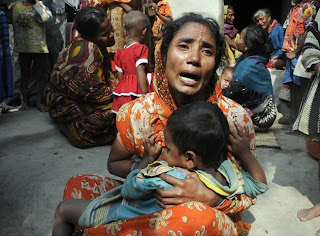Mizoram hian zu khapna dân, Mizoram Liquor Total Prohibition Act (1995) kan neih avang hian kan khawtlâng hi a himin a nuam a ni tia sawi a awm fo ṭhin. Hei hi zu khapna dân kan neih chhunzawm zêlna tûra sawrkar, kohhran, pawl leh mimal thlenga kan ṭanfung pawimawh tak pakhat pawh niin a lang. Kum 2009 pawh khan kan Excise & Narcotics Dept. commissioner chuan MLTP Act kenkawh nâna YMA hmalâkna avangin kan khawtlang chu eng hunah pawh hmeichhia leh naupangte tân a him thu a lo tlangaupui tawh hial a. Tin, 2009 vêk khan kan Synod hotu pakhat chuan MLTP Act hi 100% in hlawhtling lo mahse he dân kan neih hnua kan khawtlâng nawm sawt zia a lo sawi bawk
Mipuite himna leh muanna hi state mawhphurhna lian ber pakhat a ni a, Hobbes, Locke leh Rousseau-te ‘Social Contract’ theory pawha ‘state’ awmna chhan ber pawh a ni nghe nghe a ni. Khawtlâng himna leh muanna kawnga tûnlai Mizoram kan panna lâi ber nia lang chu ‘rape’ (pawngsual) crime hi a ni. Tute nge ‘victim’ chu kan hre tlâng e! Tûn kum, 2012, kum chanve êm pawh a la vei hma hauh pawhin he dân bawhchhiatna thuthang hi kan hre nasa tawh hle a ni. Entîrnân: New Year khan Zuangtuia TB vei patlingin naupang kum 5 mi a pawngsual; February khan police-in rualbanlo nula Lungleiah; March-ah naupang kum 8 mi N. Vanlaiphaiah leh a dang tam tak a awm tawhin a awm mêk a ni. Heng entîrna aṭang ringawt pawh hian rape crime hi kan hmeichhia leh naupangte khawtlanga an him lohna entîrtu leh an him leh him lohna tehfung pawimawh ber pakhat a ni a tih theih a ni.
Mizoram rape crime rate hi National Crime Records Bureau (NCRB) annual publication, Crime in India aṭangin a hriat theih a ni. NCRB official-te chuan ‘crime rate’ hi ‘the number of incidents per lakh population’ angin an chhût a; state tinte ‘rank of criminality’ pawh a rate sân dan indawtin an chhinchhiah ṭhin. NCRB chhinchhiahnaa Mizoram, rape crime bîka kan dinhmun, kan thlir dawn a ni.
Kum 2010 khan Mizoram hian rape crime rate 9.1 kan nei a (case 92 register niin), India state 28 leh UT 7 te zîngah sâng berin criminality rank-ah 1-na kan ni. 2009-a 8.3 rate aṭangin kan criminality chu 0.8 in a tam belh. Min hnaihtu state-te chu kan ṭhenawm, Tripura 6.6, Assam 5.6 and Meghalaya 5.7 te an ni. Zu heh ram kan tih ṭhin, Kerala (1.8), Punjab (2.0) te chu pawngsual lamah hian an khawtlâng a him fe zawk tih a hmuh theih. Tin, ‘Ram thim, Kristiante tihduhdahna ram’ kan tih, Orissa-ah pawh pawngsual rate hi 2.5 chauh a ni. Zu khapna dân nei ve tho, Gujarat leh Nagaland te erawh kum 2010 khan rape crime rate 0.07 chauh an nei thung a ni. Tin, MLTP kan neih hma 1990-1994 quinquennial (kum 5) average chu 6.14 niin MLTP hnuaiah hian rape rate hi a tlâkhniam loh mai bâkah pun lam a pan zawk a ni.
NCRB records aṭang chuan MLTP Act hnuaiah hian rape crime hi state dangte aiin a tam zawk tih a hmuh theih a, zu khapna dân hi pawngsual hluar chhan erawh a ni kher lovang (Nagaland leh Gujarat example). Amaherawhchu, pawngsual hluar êm êmna ram hi khawtlâng nuam leh muanawm chu a ni thei lovang. Kan opening paragraph-a MLTP fakna statements-te nen chuan kan records hmuh chu a inang lo hle bawk a ni. Chuvangin, kan rama pawngsual a hluar zia aṭang hian kan khawtlâng hi hmeichhiate leh naupangte tân a him lo tih hi kohhran te, sawrkar te, NGO te, chhungkua leh mimal thlengin kan pawm tlân a, MLTP-te ang ‘solution’ tling lo lutuka inṭawng thlamuana innghat mai mai tawh lova, a ‘solution’ tak tak tûr beng sika kan ngaihtuah tlân a hun tawh tak zet zet a ni.
References:
1 National Crime Records Bureau, "Crime in India" (New Delhi: Ministry of Home Affairs)
2 Adam Halliday, “Gujarat, Mizoram: United in prohibition, but different in implementation,” The Indian Express (Jul 20, 2009); available from www.indianexpress.com/news/gujarat-mizoram-united-in-prohibition-but/491430/
3 “Mizoram Church no to liquor ban Act amendment,” WebIndia123 (Jun 6, 2009); available from http://news.webindia123.com/news/articles/India/20090606/1269373.html
4. Picture available from: http://thekgexpress.files.wordpress.com/2011/08/banned-alcohol.jpg

